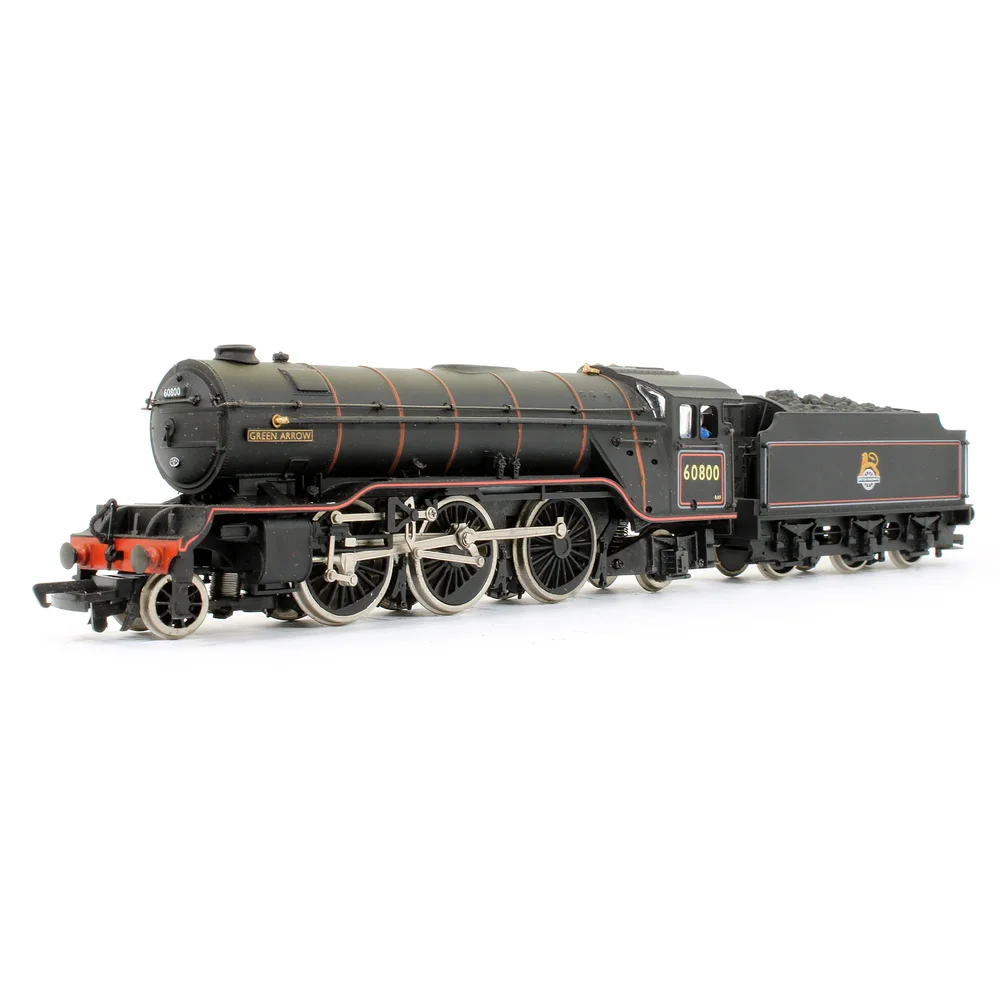Bachmann 31-551
London & North Eastern Railway V2 60800 Green Arrow British Railways Lined Black with Early Emblem
Tooling
Bachmann launched its OO gauge model of the London & North Eastern Railway (LNER) Class V2 in the early 1990s, around 1992, as part of its expanding Branchline range. This tooling represented one of Bachmann’s first attempts at producing a large British steam locomotive in OO scale, aimed at enthusiasts seeking a reliable and affordable model of Gresley’s famous mixed-traffic design.
Tooling Features
- Scale: OO gauge (1:76).
- Construction: Plastic bodyshell mounted on a die-cast split chassis frame.
- Detailing: Moulded handrails, basic cab detail, and simplified valve gear typical of early 1990s standards. Tender detail was largely integral to the moulding.
- Couplings: Standard tension-lock couplers permanently mounted; no NEM pockets.
Mechanical & Electrical
- Motor & Drive: Split chassis design with a centrally mounted motor driving the driving wheels via coupling rods. Known for adequate pulling power but prone to wear and electrical issues over time.
- Minimum Radius: Recommended for 2nd radius curves (approx. 438 mm).
- Lighting: None provided.
- Weighting: Heavy die-cast chassis provided good traction for its era.
DCC Capability
- The original 1992 tooling was not DCC-ready. Conversion required hardwiring a decoder and insulating the split chassis, which was considered challenging for beginners.
Liveries Produced
The initial tooling was offered in several authentic schemes, including:
- LNER Apple Green (with and without lining)
- BR Lined Black (early and late crest)
- BR Green (late crest)
- Special editions such as preserved No. 4771 “Green Arrow”
Reviews & Commentary
At launch, the model was praised for its overall shape and affordability but criticized for simplified detailing and the limitations of the split chassis system. Over time, reliability issues with electrical pickup and chassis wear became common discussion points among collectors. Despite these drawbacks, the model remained popular for many years as the only readily available V2 in OO gauge.
Interesting Notes
- The split chassis design was typical of Bachmann’s early steam locomotive tooling but later became obsolete due to maintenance difficulties.
- This tooling laid the groundwork for Bachmann’s later, more advanced retooling of the V2 in the 21st century.
Class & Prototype
- Class: London & North Eastern Railway V2
- Traction: Steam
- Built: 1936-1944
- Total Built: 184
- Running Number: 60800
- Name: Green Arrow
Operator & Livery
- Operator: British Railways
- Livery: Lined Black with Early Emblem
- Era: 4 - British Railways Early Emblem
British Railways transformed Britain's fragmented rail network into a unified national system following nationalisation on 1st January 1948. Created from the "Big Four" companies under the Transport Act 1947, BR operated most of Great Britain's railways until rebranding as British Rail in 1965, managing over 20,000 route miles and inheriting nearly 20,000 locomotives of diverse designs.
The organisation pioneered standardisation through its revolutionary BR Standard locomotive programme (1951-1960), producing 999 advanced steam engines under Robert Riddles' direction. These included the versatile Britannia Pacifics, mighty 9F freight engines, and mixed-traffic classes that incorporated the best features from all predecessor companies. The 1955 Modernisation Plan accelerated diesel and electric traction development, creating fascinating mixed-traction operations.
Notable achievements included establishing unified locomotive classification systems, introducing distinctive corporate liveries, and managing the complex transition from steam to modern traction. BR's six regional structure preserved operational diversity whilst enabling standardisation of practices, signalling, and rolling stock that had eluded private enterprise for over a century.
The BR era represents steam traction's final flowering alongside emerging diesel technology, creating unparalleled locomotive variety. Today, this heritage remains highly popular with railway enthusiasts through extensive preserved fleets, heritage railway operations, and comprehensive model ranges from manufacturers like Hornby, Bachmann, and Dapol, making BR subjects essential for authentic post-war British railway modelling across all scales.
British Railways' lined black livery was designated for mixed-traffic and secondary passenger locomotives from 1949, following pure LNWR style with black base colour and elaborate red, cream (off-white), and grey lining patterns. The lining specification comprised 5/8" grey, 1/8" cream, 1½" black, and ¼" red bands, with the layout consistent with LNWR practice including deep and shallow valances lined along bottom edges only, unlike green engines. The first lined black engines appeared in August 1948 when Hall 5954 appeared so painted, becoming one of the first to carry the "Lion and Wheel" emblem around the same time.
A wide range of engines was eligible for this livery, from powerful V2s and Counties down to tiny Southern Terriers, encompassing County, Hall, Grange, Manor, Saint, Prairie tanks, and numerous pre-grouping designs of varied shapes and sizes. This created many variations and interpretation problems due to the diverse locomotive types involved, with regional differences in splasher lining treatment—the Eastern Region used red-only splasher lining, whilst the Southern Region evolved from inset to edge lining styles. The emblem was positioned centrally on tender sides above the middle axle box, with the Western Region favouring larger sizes on tenders and bigger tank engines. An interesting period detail saw number plates routinely painted red from late 1949 to early 1952, adding colour contrast to the otherwise black scheme. This livery represented BR's commitment to standardising mixed-traffic operations whilst maintaining the decorative traditions that distinguished passenger-rated locomotives from plain freight engines.
